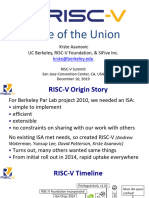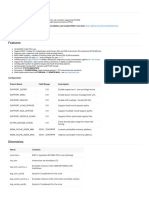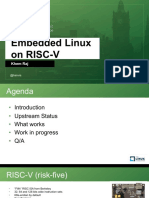Demystifying the RISC-V Linux
software stack
Nick Kossifidis - Spring 2022 RISC-V Week, Paris
�Adding a new arch
on Linux…
�Linux is huge !
~23 million lines of code and counting
~64k files in the kernel tree
Almost 2.000 developers / release
More than 20.000 developers have contributed so far
3
�A visualisation attempt
4
�Comparing /arch to the rest of the kernel
/arch -> ~1.7mloc
/{kernel, lib, mm, ipc, init} -> ~0.5mloc
/{block, net, crypto, security, fs} -> ~2mloc
/{drivers, sound} -> ~16mloc
/arch/x86 -> ~290kloc
/arch/arm -> ~272kloc
/arch/arm64 -> ~85kloc
/arch/riscv -> ~23kloc
5
�Under the hood
�RISC-V Privilege modes
Machine Mode User Mode Supervisor Mode
● Mandatory ● Optional (depends on ● Optional (depends on M-mode
● The most privileged / M-mode) and U-mode)
protected mode visible to the ● The least privileged / ● Sits between M-mode and
software (there is also Debug protected mode U-mode
mode but it’s only accessible / ● Physical/virtual memory ● Provides virtual memory
addressing / protection
visible to hw debuggers) addressing Physical/virtual
● Trap/interrupt handling through
● Physical memory addressing memory protection
delegation, managed by M-mode
● Physical memory protection ● No trap/interrupt handling
● May act as a hypervisor (aka
● Trap/Interrupt handling and
HS-mode) through the use of an
delegation
extra set of CSRs, also providing
a second stage of translation /
protection for guests (aka
VS-mode instances)
The RISC-V Privileged Spec
https://github.com/riscv/riscv-isa-manual/releases
7
�RISC-V Virtual memory
● 3 level page table for RV32 (Sv32)
● 3, 4, 5 level page tables for RV64
(Sv39/48/57)
● 2nd stage of translation for VS mode
(G-stage), managed by HS mode
● NAPOT encoding available
● Up to 16bit ASID
● SMEP always active
● SMAP controlled by sstatus.SUM bit
● Page-based memory types (Non
Cacheable, I/O) for RV64
8
�Facilities on M-mode
Provide infos on the current hardware thread (hart):
● Vendor id (mvendorid), Microarchitecture id (marchid), Implementation id (mimpid)
● Current hart’s id (hartid)
● Available hart extensions (misa, menvcfg)
● Pointer to the configuration structure (mconfigptr) from which we can also generate the device tree
or ACPI tables
Configure hart extensions (misa, menvcfg, mstatus) and security features (mseccfg)
Physical Memory Protection (PMP/ePMP)
Configure profile counters
Fixed-frequency timer (mtime) with the ability to schedule timer interrupts (mtimecmp)
Configure trap and interrupt auto-delegation to S / HS modes
9
�RISC-V Trap and interrupt delegation / mode switching
10
�RISC-V Interrupt delivery
The old way (SiFive CLINT / PLIC) The new way (RISC-V ACLINT / AIA)
● Wired interrupts only, no MSIs ● Both wired and MSIs
● Shared between privilege modes ● Different interrupt settings per privilege mode
● Directly to M-mode and then delegated (so even ● Interrupts delivered to specific privilege modes
S-mode software interrupts go through M-mode) ● Virtualization support
● No virtualization support
For more information:
https://github.com/riscv/riscv-aia
https://github.com/riscv/riscv-aclint
Advanced Interrupt Architecture and Advanced CLINT
Anup Patel, John Hauser - RISC-V Summit 2021
(https://www.youtube.com/watch?v=je9Qr23mclU)
11
�Firmware architecture
12
�Supervisor Binary Interface (SBI)
Firmware call API
● S-Mode <-> M-Mode
● HS-Mode <-> M-Mode
● VS-Mode <-> HS-Mode
Available services:
● Provide access to M-mode facilities
○ Timer, PMU, hart/imp/vendor IDs…
● Inter-Processor Interrupts (IPI)
● Remote Fence (memory barrier)
● Hart State Management (suspend/resume)
● System Reset
● …
For more information: https://github.com/riscv-non-isa/riscv-sbi-doc
13
�RISC-V OS Boot protocol
Direct: EFI stub:
● Get Device Tree through a1 gp register ● Get Device Tree through EFI Config Table
● Get Hart ID through a0 gp register ● Get Hart ID through the device tree’s
chosen/boot-hartid or through the new
RISC-V Device Tree bindings under Documentation/bindings: RISCV_EFI_BOOT_PROTOCOL
/riscv/cpus.yaml
/interrupt-controller/riscv,cpu-intc.txt
/interrupt-controller/sifive,plic-1.0.0.yaml
/cpu/cpu-topology.txt
For more information:
Atish Pattra - An introduction to RISC-V Boot flow (RISC-V Summit 2019)
https://www.youtube.com/watch?v=sPjtvqfGjnY
https://archive.fosdem.org/2021/schedule/event/firmware_uor/
https://github.com/riscv-admin/riscv-uefi-edk2-docs
arch/riscv/kernel/head.S
drivers/firmware/efi/libstub/riscv-stub.c
14
�Runtime firmware implementations
Reference implementation: OpenSBI
Can act as a standalone firmware / first stage boot loader
Useful links:
Can be used as a library for other runtime firmware implementations
https://github.com/riscv-software-src/opensbi
Used on EDK2 (EFI Runtime firmware)
Can be used for static partitioning of the system (OpenSBI Domains) https://github.com/xvisor/xvisor
https://diosix.org/
Other implementations of the SBI spec https://github.com/rustsbi/rustsbi
● Hypervisors (to provide SBI for their guests): https://github.com/jwnhy/coffer
○ KVM, Xvisor, Diosix
● RustSBI
● Coffer (Secure monitor)
15
�Current status of the
RISC-V Linux port
�The RISC-V Linux port
● Git repository:
○ https://git.kernel.org/pub/scm/linux/kernel/git/riscv/linux.git
● Documentation:
○ https://docs.kernel.org/riscv/index.html
● Use a recent gcc toolchain:
○ E.g.: https://github.com/riscv-collab/riscv-gnu-toolchain
● Supported systems on mainline:
○ QEMU RISC-V Virt machine
○ SiFive Hifive Unleashed / Unmatched
○ PolarFire SoC FPGA Icicle Kit
○ Kendryte 210 (NOMMU, Linux runs on M-mode)
○ Allwinner D1 (Work in Progress)
● Supported systems with custom patches
○ LowRISC
○ Beagle-V
○ …
17
�The evolution of /arch/riscv
18
�RISC-V Extension support
Virtual memory extensions:
● Sv32, Sv39 / Sv32x4, Sv39x4 supported
● Sv48 / Sv48x4 supported (Alex Ghiti, Anup Patel)
● Sv57 / Sv57x4 supported (Qinglin Pan, Anup Patel)
● ASID allocator supported (Anup Patel)
● Page-based memory types (Svpbmt) submitted (v9 Heiko Stuebner)
● Fast TLB invalidation (Svinval) submitted (v2 Mayuresh Chitale)
● NAPOT pages (Svnapot) submitted (v1 Qinglin Pan)
H(ypervisor) extension supported (Anup Patel)
V(ector) extension submitted (v9 Greentime Hu, Guo Ren, Vincent Chen)
S and VS level Time Compare (Sstc) submitted (v3 Atish Patra, also v2 on OpenSBI)
Cache Management Operations Base (Zicbo*) submitted (v1 Heiko Stuebner -waiting for toolchain support)
Profiling through PMU (including Sscofpmf) supported (Atish Patra)
Pending:
● Scalar crypto support on CryptoAPI
● Arch-specific RNG (Zkr from scalar crypto)
19
�Linux features support
Feature status (30/42): https://docs.kernel.org/riscv/features.html
Work in progress:
● Queued RWlocks submitted (v4 Palmer Dabbelt)
● HAVE_ARCH_HUGE_VMAP (v2 Liu Shixin, also part of Svnapot patchset)
Supported features not included on features list:
● CPU Idle, CPU Hot Plugging (through SBI HSM) (Anup Patel, Atish Patra)
● kexec/kdump (Nick Kossifidis)
● Alternatives framework (Vincent Chen, Heiko Stuebner)
● Restartable Sequences (RSEQ) (Vincent Chen)
● Strict kernel/module RWX (Zong Li, Jisheng Zhang)
● XIP image (Alex Ghiti)
● NOMMU support (userspace is WiP) (Christoph Hellwig)
● NUMA (Greentime Hu)
● EFI Stub (Atish Patra)
● …
20
�The development
process…
�It’s a challenge for everyone involved
RISC-V is a unique architecture
We are not one company that has control over the whole process
Everything happens in parallel, the spec, the simulators, the toolchain etc
We have limited hardware to play with, development happens mostly on QEMU
Due to the modular nature of RISC-V we need to support all possible configurations
We need to support vendor extensions on top of standard extensions
We need to handle hw errata in sw
We need to be able to provide one image that boots everywhere
But things are getting better
Check out the talks from Philipp Tomsich and Mark Himelstein on Thursday
22
�A few examples to get an idea
Cache management operations & Page-based memory types
Vector support
Kendryte 210 draft MMU
Allwinner D1 noncompliant Sv39
23
�A few examples from EPAC to get an idea
Unique memory layout
Device tree outside of linear mapping
1:1 physical/virtual mapping (used for Sv48/Sv57 detection) is invalid in our case
Kdump worked fine on QEMU but not on HiFive boards
For more information on EPAC check out tomorrow’s talk from Jesús Labarta
The Accelerator Tile of European Processor Initiative
24
�Alternatives and static keys
Alternatives framework:
Provide alternative assembly code snippets that can override the default implementation
through in-memory live patching of the kernel image.
Example:
Implement standard page-based memory types on supported implementations
Implement custom Allwinner D1 equivalent
Static keys:
Same concept of live patching but focused on branches
25
�The heroes…
Top 10 contributors:
1. 97 Atish Patra
2. 91 Palmer Dabbelt
3. 87 Christoph Hellwig
4. 84 Anup Patel
5. 60 Jisheng Zhang
6. 59 Kefeng Wang
7. 55 Zong Li
8. 54 Alexandre Ghiti
9. 37 Vincent Chen
10. 30 Damien Le Moal
26
�Next steps…
�Upcoming features
IOMMU
Check out RISC-V IOMMU Architecture Overview from Perrine Peresse on Thursday
Secure Boot / Root of trust
Vector crypto
AP-TEE architecture
MPU
IOPMP
Check out RISC-V : Securing the Future of Open Source Computing from Andrew Dellow on Thursday
And many more
Check out State of the Union & the Road Ahead from Mark Himelstein on Thursday
28
�Questions ?
�Thank you !
























































































